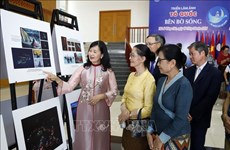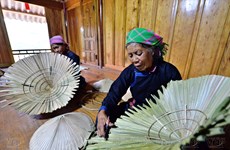Traditional music of capital to be released
A DVD set featuring the traditional music of Hanoi will be released
later this month in honour of the capital's millennium in October.
A DVD set featuring the traditional music of Hanoi will be released
later this month in honour of the capital's millennium in October.
The set, which is the first of its kind, includes four DVDs featuring the history of Hanoi 's traditional music, including songs and music works in different styles performed by veteran and young singers and musicians. Most of them work for the city's traditional theatres.
The DVD-producer Music Publishing House invested a great deal of money and human resources to record and film the artists on stage and in daily life.
The film's directors, People's Artist Tran Van Thuy and Nguyen Si Chung, perfected the film with beautiful scenes and music.
Veteran artists Thanh Ngoan, Xuan Hach, Minh Anh and The Dan, four of the region's leading traditional singers and music players, perform at their best in the film.
"Our artists' performances and talks provide audiences with the knowledge and beauty of traditional music and instruments," said Chung, the film's director.
He also added that through the DVD audiences could improve their knowledge of the different forms of music and could sing traditional tunes.
The film will be available in bookstores to celebrate 1,000 years of Hanoi . The film highlights Ca Tru, Hat Xam and Canh Hong Tu, three popular genres of music in the royal citadel of Thang Long (former name of Hanoi ).
Ca Tru (also known as Hat A Dao or ceremonial singing), an ancient genre of chamber music, features female vocalists who sing while playing music on bamboo tablets.
This was associated with a geisha-like form of entertainment.
The music was inscribed on the list of Intangible Cultural Heritage in need of Urgent Safeguarding in 2009 by the United Nations Educational, Scientific and Cultural Organisation (UNESCO).
Hat Xam (blind buskers music) is a type of folk music dating from the Tran Dynasty in the 14th century.
It was generally performed by blind buskers who travelled around the citadel to earn their living by singing in common places like markets.
Xam artists often play Dan Bau (monochord) or Dan Nhi (two-chord fiddle) to accompany the song themselves. The most famous surviving artisan of the art form is Ha Thi Cau, a Hanoi resident.
Canh Hong Tu is the kind of music used in religious ceremonies which dates back thousands of years ago in Thang Long./.
The set, which is the first of its kind, includes four DVDs featuring the history of Hanoi 's traditional music, including songs and music works in different styles performed by veteran and young singers and musicians. Most of them work for the city's traditional theatres.
The DVD-producer Music Publishing House invested a great deal of money and human resources to record and film the artists on stage and in daily life.
The film's directors, People's Artist Tran Van Thuy and Nguyen Si Chung, perfected the film with beautiful scenes and music.
Veteran artists Thanh Ngoan, Xuan Hach, Minh Anh and The Dan, four of the region's leading traditional singers and music players, perform at their best in the film.
"Our artists' performances and talks provide audiences with the knowledge and beauty of traditional music and instruments," said Chung, the film's director.
He also added that through the DVD audiences could improve their knowledge of the different forms of music and could sing traditional tunes.
The film will be available in bookstores to celebrate 1,000 years of Hanoi . The film highlights Ca Tru, Hat Xam and Canh Hong Tu, three popular genres of music in the royal citadel of Thang Long (former name of Hanoi ).
Ca Tru (also known as Hat A Dao or ceremonial singing), an ancient genre of chamber music, features female vocalists who sing while playing music on bamboo tablets.
This was associated with a geisha-like form of entertainment.
The music was inscribed on the list of Intangible Cultural Heritage in need of Urgent Safeguarding in 2009 by the United Nations Educational, Scientific and Cultural Organisation (UNESCO).
Hat Xam (blind buskers music) is a type of folk music dating from the Tran Dynasty in the 14th century.
It was generally performed by blind buskers who travelled around the citadel to earn their living by singing in common places like markets.
Xam artists often play Dan Bau (monochord) or Dan Nhi (two-chord fiddle) to accompany the song themselves. The most famous surviving artisan of the art form is Ha Thi Cau, a Hanoi resident.
Canh Hong Tu is the kind of music used in religious ceremonies which dates back thousands of years ago in Thang Long./.













